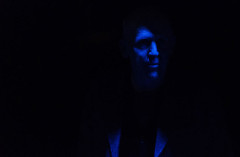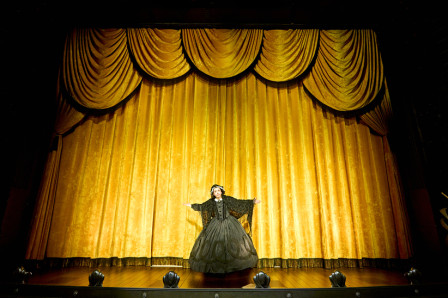Review: HOW IT IS (PART 1) at the Print Room at the Coronet
 Seated on the stage, the audience gazes at the steep rake of The Coronet's empty stalls and balcony, shrouded in gloom, the peeling walls and bits of scaffolding creating an atmosphere of a building almost falling apart, artfully disintegrating. Maybe there is time for one more performance before it crumbles. Perfect for Samuel Beckett.
Seated on the stage, the audience gazes at the steep rake of The Coronet's empty stalls and balcony, shrouded in gloom, the peeling walls and bits of scaffolding creating an atmosphere of a building almost falling apart, artfully disintegrating. Maybe there is time for one more performance before it crumbles. Perfect for Samuel Beckett.
How It is (part one) is a staging by Gare St Lazare, Ireland, of Beckett's last full-length novel, originally written in French and translated into English by the Nobel Prize-winning author himself in 1964.
We are are in familiar territory; mud and memories, clinging on to existence with language both repetitive and poetic. The unnamed narrator, clutching his sack of tins that provide sustenance and something to worry about, crawls through the filth, remembering and being reminded of an earlier time, how it was 'before Pim'.
As staged here, the bulk of the punctuation-less prose is divided between Conor Lovett and Stephen Dillane with sound designer Mel Mercier joining in to confuse matters every now and then. The words are sometimes spoken by all three, a beat apart, the echo effect creating a vast space of sound, ringing round the dilapidated building, sometimes two will speak in unison, from different parts of the auditorium. Figures, barely lit, will slip out of doors in the balcony to re- emerge in front of the audience to continue the litany of how it is and how it was.
A constant electronic rumble accompanies the words, suddenly it ear-splittingly drowns them. Were those sirens part of the sound design or a seepage from the nightmare that is Notting Hill High Street? Whatever, it worked a treat though there were times when it felt like we were attending a sound installation piece rather than a 'play'.
No praise can be too high for the performers. Conor Lovett with his slightly quizzical, beautifully modulated approach and Stephen Dillane's more assured, naturalistic manner that, wonderfully, turned into Shakespearean rhythms and cadences in his longest speech, gave texture and variety to a long evening of tough language. This is not for Beckett initiates or haters.
Visually there were times the action seemed a bit strained, trying hard not to be too static. The opening, with its fringe-like introductions and backs-to-the-audience nonchalance, needs looking at but once we and it settle into the rhythm and unmistakable texture of Beckett's glorious sound world this adaptation works like a dream. Or a nightmare.
Latest News

 Cast announced for Deep Azure at Shakespeare's Globe
12 December 2025 at 14:32
Cast announced for Deep Azure at Shakespeare's Globe
12 December 2025 at 14:32

 Production images released for Oh, Mary! West End premiere
12 December 2025 at 14:00
Production images released for Oh, Mary! West End premiere
12 December 2025 at 14:00

 Into the Woods at Bridge Theatre Review
12 December 2025 at 13:57
Into the Woods at Bridge Theatre Review
12 December 2025 at 13:57

 Review Round-Up: INTO THE WOODS at the Bridge Theatre
12 December 2025 at 13:05
Review Round-Up: INTO THE WOODS at the Bridge Theatre
12 December 2025 at 13:05
